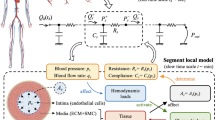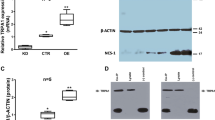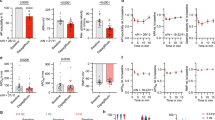Abstract
Arachidonic acid (AA) is a polyunsaturated fatty acid involved in a complex network of cell signaling. It is well known that this fatty acid can directly modulate several cellular target structures, among them, ion channels. We explored the effects of AA on high conductance Ca2+- and voltage-dependent K+ channel (BKCa) in vascular smooth muscle cells (VSMCs) where the presence of β1-subunit was functionally demonstrated by lithocholic acid activation. Using patch-clamp technique, we show at the single channel level that 10 μM AA increases the open probability (Po) of BKCa channels tenfold, mainly by a reduction of closed dwell times. AA also induces a left-shift in Po versus voltage curves without modifying their steepness. Furthermore, AA accelerates the kinetics of the voltage channel activation by a fourfold reduction in latencies to first channel opening. When AA was tested on BKCa channel expressed in HEK cells with or without the β1-subunit, activation only occurs in presence of the modulatory subunit. These results contribute to highlight the molecular mechanism of AA-dependent BKCa activation. We conclude that AA itself selectively activates the β1-associated BKCa channel, destabilizing its closed state probably by interacting with the β1-subunit, without modifying the channel voltage sensitivity. Since BKCa channels physiologically contribute to regulation of VSMCs contractility and blood pressure, we used the whole-cell configuration to show that AA is able to activate these channels, inducing significant cell hyperpolarization that can lead to VSMCs relaxation.








Similar content being viewed by others
References
Ahn DS, Kim YB, Lee YH, Kang BS, Kang DH (1994) Fatty acids directly increase the activity of Ca(2+)-activated K+ channels in rabbit coronary smooth muscle cells. Yonsei Med J 35(1):10–24
Aldrich RW, Corey DP, Stevens CF (1983) A reinterpretation of mammalian sodium channel gating based on single channel recording. Nature 306(5942):436–441
Bao L, Cox DH (2005) Gating and ionic currents reveal how the BKCa channel’s Ca2+ sensitivity is enhanced by its beta1 subunit. J Gen Physiol 126(4):393–412. doi:10.1085/jgp.200509346
Bendahhou S, Cummins TR, Agnew WS (1997) Mechanism of modulation of the voltage-gated skeletal and cardiac muscle sodium channels by fatty acids. Am J Physiol 272(2 Pt 1):C592–C600
Bukiya AN, Liu J, Toro L, Dopico AM (2007) Beta1 (KCNMB1) subunits mediate lithocholate activation of large-conductance Ca2+-activated K+ channels and dilation in small, resistance-size arteries. Mol Pharmacol 72(2):359–369. doi:10.1124/mol.107.034330
Bukiya AN, Singh AK, Parrill AL, Dopico AM (2011) The steroid interaction site in transmembrane domain 2 of the large conductance, voltage-and calcium-gated potassium (BK) channel accessory beta1 subunit. Proc Natl Acad Sci U S A 108(50):20207–20212. doi:10.1073/pnas.1112901108
Bukiya AN, Vaithianathan T, Toro L, Dopico AM (2009) Channel beta2-4 subunits fail to substitute for beta1 in sensitizing BK channels to lithocholate. Biochem Biophys Res Commun 390(3):995–1000. doi:10.1016/j.bbrc.2009.10.091
Burtis CA, Ashwood ER, Bruns DE (2006) Tietz textbook of clinical chemistry and molecular diagnostics, 4th edn. Elsevier Saunders, St.Louis
Campbell WB, Falck JR (2007) Arachidonic acid metabolites as endothelium-derived hyperpolarizing factors. Hypertension 49(3):590–596. doi:10.1161/01.HYP.0000255173.50317.fc
Carl A, Sanders KM (1990) Measurement of single channel open probability with voltage ramps. J Neurosci Methods 33(2–3):157–163
Clarke AL, Petrou S, Walsh JV Jr, Singer JJ (2002) Modulation of BK(Ca) channel activity by fatty acids: structural requirements and mechanism of action. Am J Physiol Cell Physiol 283(5):C1441–C1453. doi:10.1152/ajpcell.00035.2002
Denson DD, Wang X, Worrell RT, Eaton DC (2000) Effects of fatty acids on BK channels in GH(3) cells. Am J Physiol Cell Physiol 279(4):C1211–C1219
Feletou M, Vanhoutte PM (2009) EDHF: an update. Clin Sci (Lond) 117(4):139–155. doi:10.1042/CS20090096
Ferroni S, Valente P, Caprini M, Nobile M, Schubert P, Rapisarda C (2003) Arachidonic acid activates an open rectifier potassium channel in cultured rat cortical astrocytes. J Neurosci Res 72(3):363–372. doi:10.1002/jnr.10580
Fink M, Lesage F, Duprat F, Heurteaux C, Reyes R, Fosset M, Lazdunski M (1998) A neuronal two P domain K+ channel stimulated by arachidonic acid and polyunsaturated fatty acids. EMBO J 17(12):3297–3308. doi:10.1093/emboj/17.12.3297
Gavrilova-Ruch O, Schonherr R, Heinemann SH (2007) Activation of hEAG1 potassium channels by arachidonic acid. Pflugers Arch 453(6):891–903. doi:10.1007/s00424-006-0173-3
Gonzalez-Corrochano R, La Fuente J, Cuevas P, Fernandez A, Chen M, Saenz de Tejada I, Angulo J (2013) Ca2+ -activated K+ channel (KCa) stimulation improves relaxant capacity of PDE5 inhibitors in human penile arteries and recovers the reduced efficacy of PDE5 inhibition in diabetic erectile dysfunction. Br J Pharmacol 169(2):449–461. doi:10.1111/bph.12143
Gonzalez C, Baez-Nieto D, Valencia I, Oyarzun I, Rojas P, Naranjo D, Latorre R (2012) K(+) channels: function-structural overview. Compr Physiol 2(3):2087–2149. doi:10.1002/cphy.c110047
Hamill OP, Marty A, Neher E, Sakmann B, Sigworth FJ (1981) Improved patch-clamp techniques for high-resolution current recording from cells and cell-free membrane patches. Pflugers Arch 391(2):85–100
Hoshi T, Tian Y, Xu R, Heinemann SH, Hou S (2013) Mechanism of the modulation of BK potassium channel complexes with different auxiliary subunit compositions by the omega-3 fatty acid DHA. Proc Natl Acad Sci U S A 110(12):4822–4827. doi:10.1073/pnas.1222003110
Hoshi T, Wissuwa B, Tian Y, Tajima N, Xu R, Bauer M, Heinemann SH, Hou S (2013) Omega-3 fatty acids lower blood pressure by directly activating large-conductance Ca(2)(+)-dependent K(+) channels. Proc Natl Acad Sci U S A 110(12):4816–4821. doi:10.1073/pnas.1221997110
Katz AM, Messineo FC (1981) Lipid-membrane interactions and the pathogenesis of ischemic damage in the myocardium. Circ Res 48(1):1–16
Klockner U (1993) Intracellular calcium ions activate a low-conductance chloride channel in smooth-muscle cells isolated from human mesenteric artery. Pflugers Arch 424(3–4):231–237
Knaus HG, Folander K, Garcia-Calvo M, Garcia ML, Kaczorowski GJ, Smith M, Swanson R (1994) Primary sequence and immunological characterization of beta-subunit of high conductance Ca(2+)-activated K+ channel from smooth muscle. J Biol Chem 269(25):17274–17278
Knaus HG, Garcia-Calvo M, Kaczorowski GJ, Garcia ML (1994) Subunit composition of the high conductance calcium-activated potassium channel from smooth muscle, a representative of the mSlo and slowpoke family of potassium channels. J Biol Chem 269(6):3921–3924
Latorre R, Brauchi S (2006) Large conductance Ca2+-activated K+ (BK) channel: activation by Ca2+ and voltage. Biol Res 39(3):385–401
Liu G, Niu X, Wu RS, Chudasama N, Yao Y, Jin X, Weinberg R, Zakharov SI, Motoike H, Marx SO, Karlin A (2010) Location of modulatory beta subunits in BK potassium channels. J Gen Physiol 135(5):449–459. doi:10.1085/jgp.201010417
Liu G, Zakharov SI, Yang L, Wu RS, Deng SX, Landry DW, Karlin A, Marx SO (2008) Locations of the beta1 transmembrane helices in the BK potassium channel. Proc Natl Acad Sci U S A 105(31):10727–10732. doi:10.1073/pnas.0805212105
Liu L, Rittenhouse AR (2003) Arachidonic acid mediates muscarinic inhibition and enhancement of N-type Ca2+ current in sympathetic neurons. Proc Natl Acad Sci U S A 100(1):295–300. doi:10.1073/pnas.0136826100
Marijic J, Li Q, Song M, Nishimaru K, Stefani E, Toro L (2001) Decreased expression of voltage-and Ca(2+)-activated K(+) channels in coronary smooth muscle during aging. Circ Res 88(2):210–216
Martin P, Enrique N, Palomo AR, Rebolledo A, Milesi V (2012) Bupivacaine inhibits large conductance, voltage-and Ca2+-activated K+ channels in human umbilical artery smooth muscle cells. Channels (Austin) 6(3):174–180. doi:10.4161/chan.20362
Meves H (2008) Arachidonic acid and ion channels: an update. Br J Pharmacol 155(1):4–16. doi:10.1038/bjp.2008.216
Milesi V, Raingo J, Rebolledo A, Grassi de Gende AO (2003) Potassium channels in human umbilical artery cells. J Soc Gynecol Investig 10(6):339–346
Moreno C, Macias A, Prieto A, De La Cruz A, Valenzuela C (2012) Polyunsaturated fatty acids modify the gating of kv channels. Front Pharmacol 3:163. doi:10.3389/fphar.2012.00163
Morin C, Sirois M, Echave V, Gomes MM, Rousseau E (2007) Functional effects of 20-HETE on human bronchi: hyperpolarization and relaxation due to BKCa channel activation. Am J Physiol Lung Cell Mol Physiol 293(4):L1037–L1044. doi:10.1152/ajplung.00145.2007
Munaron L (2011) Shuffling the cards in signal transduction: calcium, arachidonic acid and mechanosensitivity. World J Biol Chem 2(4):59–66. doi:10.4331/wjbc.v2.i4.59
Nelson MT, Quayle JM (1995) Physiological roles and properties of potassium channels in arterial smooth muscle. Am J Physiol 268(4 Pt 1):C799–C822
Qiu Y, Quilley J (1999) Vascular effects of arachidonic acid in the rat perfused heart. Role of the endothelium, cyclooxygenase, cytochrome P450, and K(+) channels. J Lipid Res 40(12):2177–2184
Radenkovic M, Grbovic L, Radunovic N, Momcilov P (2007) Pharmacological evaluation of bradykinin effect on human umbilical artery in normal, hypertensive and diabetic pregnancy. Pharmacol Rep PR 59(1):64–73
Raingo J, Rebolledo A, Iveli F, Grassi de Gende AO, Milesi V (2004) Non-selective cationic channels (NSCC) in smooth muscle cells from human umbilical arteries. Placenta 25(8–9):723–729. doi:10.1016/j.placenta.2004.01.028
Shouk TA, Omar MN, Fayed ST (1999) Essential fatty acids profile and lipid peroxides in severe pre-eclampsia. Ann Clin Biochem 36(Pt 1):62–65
Smyth EM, Burke A, FitzGerald GA (2006) Lipid-derived autacoids: eicosanoids and platelet-activating factor. In: Brunton LL (ed) Goodman and Gilman’s the pharmacological basis of therapeutics, 11th edn. Mc Graw-Hill, New York, pp 653–670
Sun X, Zhou D, Zhang P, Moczydlowski EG, Haddad GG (2007) Beta-subunit-dependent modulation of hSlo BK current by arachidonic acid. J Neurophysiol 97(1):62–69. doi:10.1152/jn.00700.2006
Sweet TB, Cox DH (2009) Measuring the influence of the BKCa {beta}1 subunit on Ca2+ binding to the BKCa channel. J Gen Physiol 133(2):139–150. doi:10.1085/jgp.200810129
Yang Y, Li PY, Cheng J, Mao L, Wen J, Tan XQ, Liu ZF, Zeng XR (2013) Function of BKCa channels is reduced in human vascular smooth muscle cells from Han Chinese patients with hypertension. Hypertension 61(2):519–525. doi:10.1161/HYPERTENSIONAHA.111.00211
Zheng HF, Li XL, Jin ZY, Sun JB, Li ZL, Xu WX (2005) Effects of unsaturated fatty acids on calcium-activated potassium current in gastric myocytes of guinea pigs. World J Gastroenterol 11(5):672–675
Acknowledgments
The authors wish to thank Ms. Anabel Poch and the staff of the Instituto Central de Medicina for the collection of umbilical cords. This study was financially supported by grant PIP 0202 from the Consejo Nacional de Investigaciones Científicas y Técnicas (CONICET), Argentina, and by FONDECYT Grants 1120802, Anillo ACT 1104 (to Carlos Gonzalez), and the Chile–Argentina exchange grant 2011-665 CH/11/12 (to Veronica Milesi and Carlos Gonzalez from the Centro Interdisciplinario de Neurociencia de Valparaíso (The Interdisciplinary Center for Neuroscience in Valparaiso), a Millennium Institute.
Dr. Jesica Raingo generously contributed to this work by providing HEK293T cells, eGFP, and vector. We are grateful to Dr. Alejandro Rebolledo for critical feedback on the manuscript and to Francina Agosti for her helpful assistance in cell culturing and transfection.
Author information
Authors and Affiliations
Corresponding author
Additional information
P. Martín and M. Moncada contributed equally to this work.
Rights and permissions
About this article
Cite this article
Martín, P., Moncada, M., Enrique, N. et al. Arachidonic acid activation of BKCa (Slo1) channels associated to the β1-subunit in human vascular smooth muscle cells. Pflugers Arch - Eur J Physiol 466, 1779–1792 (2014). https://doi.org/10.1007/s00424-013-1422-x
Received:
Revised:
Accepted:
Published:
Issue Date:
DOI: https://doi.org/10.1007/s00424-013-1422-x




